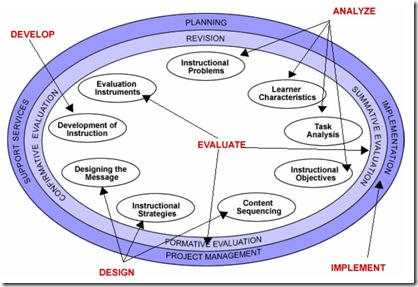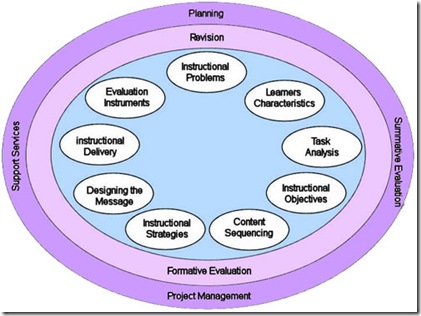The Morrison, Ross and Kemp Model, more commonly known as the Kemp Model defines different elements – not “step, stage, level, or sequential item” (Morrison, Ross & Kemp 2004, p.10) of an instructional design, and emphasizes the adoption of continuous implementation and evaluation through the instructional design process.
According to Morrison et al, there are nine key elements to instructional design:
- Identify instructional problems, and specify goals for designing an instructional program.
- Examine learner characteristics that should receive attention during planning.
- Identify subject content, and analyze task components related to stated goals and purposes.
- State instructional objectives for the learner.
- Sequence content within each instructional unit for logical learning.
- Design instructional strategies so that each learner can master the objectives.
- Plan the instructional message and delivery.
- Develop evaluation instruments to assess objectives.
- Select resources to support instruction and learning activities.
These elements are independent of each other, in that they do not need to be considered in a linear fashion and there is no particular start- and end point. The oval shape of this model (see Figure 1) is constructed to convey the idea that the design and development process is an iterative cycle that needs constant planning, design, development and assessment to ensure effective instruction.
Figure 1. The Morrison-Ross-Kemp Model
[Click to enlarge]
The model is systemic and nonlinear; it encourages designers to work in all areas of ID as appropriate. The use of ovals emphasizes this flexibility visually; the graphical design communicates a continuous non-linear cycle that requires iterative planning, design, development and assessment. The inner oval (surrounding the core) illustrates that revision/formative evaluation activities can be undertaken at each stage of the development process, something that is not always built into other models, usually because of the constraints of time and money.
The outer oval includes a typical post-instruction activity (summative evaluation) and also highlights three elements usually absent from other models – namely project planning, project management, and support services. The latter are required both for the project itself while it is in development, and afterwards to support the actual instruction.
We can say that it describes a holistic approach to instructional design that considers all factors in the environment; the starting point and order in which the designer addresses them is not prescribed, though the elements in the model may form a logical design sequence when read anti-clockwise (see Figure 2).
 Figure 1. The ADDIE steps applied to the M-R-K Model
Figure 1. The ADDIE steps applied to the M-R-K Model
(after Morrison, Ross & Kemp 2004, p.29)
[Click to enlarge]
The flexibility of this approach is reinforced by the absence of lines or arrows that would dictate a specific design sequence (see Dick and Carey's Model) as a comparison. According to Presenera (2002) the Kemp Model is designed to primarily to appeal to (classroom-based) teachers, who may not have specific instructional design experience.
The Morrison-Ross-Kemp model has three characteristics that differentiate it from some other models:
- instruction is considered from the perspective of the learner
- the model takes a general systems or even object-oriented view towards instructional development
- the model emphasizes management of the instructional design process
Using the model
Using this model the instructional designer begins by asking six questions related to the skills or knowledge to be learned: required level of learner readiness; instructional strategies and media that are be most appropriate for the content and the target population; level of learner support required; measurement of achievement; and strategies for formative and summative evaluation.
(Morrison, Ross, and Kemp, 2004, p. 4).
Because of the lack of connectivity between elements and the facility for IDs to start at any place within the model, a designer can examine the entire scope of a project - or just as effectively work on a single learning object or lesson. Using this classroom-oriented model, an individual with little instructional design skill can develop a piece of instruction using few or no additional resources and with minimal front-end analysis. Similarly, there is no requirement to conduct formative and summative evaluation on the final materials (Gustafson and Branch 2002, p.16). A more experienced designer (or one with access to more resources) can also use this model in the design of a complex and widely-distributed learning program.
___________
References:
Gustafson, K. L., & Branch, R. M. (2002). What is instructional design? In R.A. Reiser & J. A. Dempsey (Eds.), Trends and issues in instructional design and technology (pp. 16-25). Saddle River, NJ: Merrill/Prentice-Hall.
Kemp, J. E. (1985). The instructional design process. New York: Harper & Row.
Kemp, J. E., Morrison, G. R., & Ross, S. V. (2004). Design effective instruction, (4th Ed.). New York: John Wiley & Sons
Prestera, Gus. (2002). Instructional Design Models [Internet]. Available from: http://www.effectperformance.com/sites/prestera/html/M4/L1%20-%20ISD/M4L1P1.htm#kemp Accessed: 3rd June 2009
--






No comments:
Post a Comment